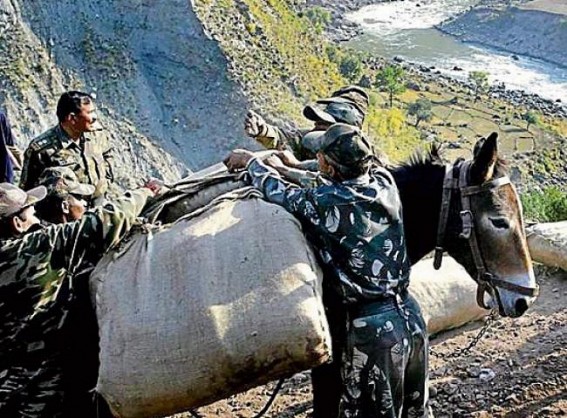Anjali Ojha

PHOTO : TIWN File Photo
The Indian Army honoured its longest serving mule "Pedongi" by naming an Army mess after it, but there was a time when the Army had decided to mark the end of the road for the sturdy mule, that has walked miles on some of the most treacherous tracks providing logistics support in difficult situations.
Just before the Kargil war, there was a proposal to disband the Animal Transport units that come under Indian Army Service Corps, consisting of sturdy mules.
But during the Kargil war, Pakistani intruders came inside Indian territory in the Drass and Kargil mountainous areas. National Highway 1, that connects Srinagar with Leh and cuts through Kargil, witnessed infiltration and fighting along a 160-km-long stretch of ridges overlooking this only motorable road.
"The situation was such that it appeared the line of communication would be cut. At that time the mules played an important role in ensuring supplies reached," an Army official, who did not want to be named, told IANS.
Availability of local ponies had also gone down as bombing started, and even helicopters could not operate because of difficult weather.
The Animal Transport unit was used at that time to provide logistics support to Indian posts and troops fighting in the sector.
"Finally the Animal Transport unit was the only available resource that worked in the face of intense shelling. The mules could go through tracks on which no vehicle could reach," the official said.
"The dauntless and loyal military mules of the Army Service Corps have enabled last-mile logistics supply in the most inhospitable conditions along our frontiers in all past wars and operations in the highest tradition of the Indian Army."
The Indian Army at present has a 6,000-strong force of mules, which continue to be the reliable last-mile transport in difficult Himalayan terrain along the Indian borders in the western as well as eastern sectors.
At a smaller scale, mules are also used in the central sector.
Pedongi, after whom a new lounge at the Central Army Service Corps (ASC) officers' mess on Polo Road has been named, has the distinction of being the longest-serving mule with the Indian Army, serving for 37 years, while average mules serve for 18-20 years.
Pedongi had joined the Indian Army in 1962, and served till his death on March 25, 1998. He also found a place in the Guinness Book of World Records as the longest-serving military mule.
While the Indian Army is considering other options for transport in the difficult mountainous terrain, and considering drones as an option among other things, in the modern world battles the mules have not lost their place.
The mules have remained relevant since the World Wars. American forces that landed in Afghanistan in 2001 to fight the Taliban had to employ mules to transfer loads in the treacherous mountain terrain.
The US Army's last Cavalry units had given up their horses in the 1940s and the last pack animals were phased out in the 1950s.
However, the animals gained significance again in Afghanistan and a new Army field manual was issued June 16, 2004, with the title, 'Special Forces Use of Pack Animals'. A formal pack animal training course was also started at the Marine Corps Mountain Warfare Training Center, Bridgeport, California.
In the Indian Army, the mules are categorised on the basis of the kind of load they carry, being broadly divided into Mule Arti -- which carry guns and weapons, and Mules GS -- that carry general supply ranging from food to medicine and even water.
The around 6,000 mules are divided into 15 units. Usually a company has three troopers and 96 animals. Each animal also has one to two handlers, depending on the load and terrain.
An Army official, recounting the services rendered by the mules in the difficult areas along the border, said a mule had once strayed and was taken in by the Pakistani troops who then started using it for load-bearing along with their own mules.
"One fine day, the mule remembered its way back home. That day he was leading the other mules that were transporting supplies for the Pakistani troops. The mule, along with other mules that belonged to the Pakistan Army and their supplies, walked straight back to our post," the officer recounted with a laugh.
- Why Modi’s BJP swept key India regional elections
- TIWN’s landmark legal victory against BJP Govt’s Illegal attacks to shutdown fearless Media
- India to be world's third-largest economy by 2030 -S&P Global Ratings
- Tripura's Dark Era : Mafia style Brutal attacks on Journalists, fight for your Citizen rights !
- How to access tripurainfoway.com via HOLA from India



